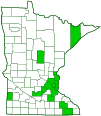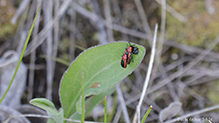goldenrod leaf miner beetle
(Microrhopala vittata)
Conservation • Description • Habitat • Ecology • Distribution • Taxonomy
|
|
||||||||||||||
Description |
Goldenrod leaf miner beetle is a small, widely distributed, hispine leaf beetle. It occurs across the United States and southern Canada except for the southeast and the far southwest. It is uncommon in Minnesota. Adults are found from late May to late August feeding on the flowers and leaves of goldenrods in the Solidago and Euthamia genera. They feed on the upper leaf surface, removing the soft tissue between the veins, and leaving short, straight trails. Larvae mine the leaves of the same species. They feed between the upper and lower leaf surfaces, leaving meandering trails. The adult is 3⁄16″ to ¼″ (5 to 7 mm) in length. The body is elongated and nearly parallel-sided, only slightly widened toward the rear. It is black with orangish-red markings, but this coloration is somewhat variable. Some individuals are mostly jet black with bright, highly contrasting, orangish-red markings. Others are reddish-black with dull, slightly contrasting, blackish-red markings. The head is orangish-red and slants backward. The compound eyes are small and black. They are not notched. The distance between an eye and the mouth is equal to the length of the third antenna segment. The mouth parts are small. The antennae are short, less than half as long as the body, and gradually enlarged toward the tip. They are usually black, sometimes reddish. They have 11 segments but the terminal segments are fused together, making them appear to have just 8 segments. The third segment is shorter that the first two segments combined. The hardened plate on the upper side of the thorax (pronotum) is reddish and rectangular. The sides narrow slightly toward the head. It is broader at the front than the head and narrower at the rear than the base of the hardened forewings (elytra). The front margin is narrowly transparent. The elytra are long, covering the entire abdomen. They are gradually and evenly curved at the tip. The margins are never toothed. They have rows of punctures bordered by distinct ridges. There is a single reddish stripe on each elytron. There is no reddish spot near the tip. The legs are black. The last part of each leg (tarsus), corresponding to the foot, is black and has 5 segments. The fourth segment is very short and is concealed within the broadened tip of the third segment, making the tarsus appear to have only four segments. |
Size |
Total length: 3⁄16″ to ¼″ (5 to 7 mm) |
Similar Species |
Habitat |
Goldenrods |
Ecology |
Season |
Late May to late August (CCESR) |
Behavior |
The larvae is a leaf miner. It feeds between the upper and lower leaf surfaces, leaving a meandering trail. The adult is a skeletonizer. It feeds on the upper leaf surface, removing the soft tissue between the veins, and leaving a short, straight trail. |
Life Cycle |
The female lays clusters of eggs on the underside of a leaf of a host plant. |
Larva Food |
Leaves of goldenrods (Solidago spp. and Euthamia spp.) |
Adult Food |
Leaves and flowers of goldenrods (Solidago spp. and Euthamia spp.) |
Distribution |
||
|
Sources |
|
| 5/10/2024 | ||
Occurrence |
||
|
||
Taxonomy |
|
Order |
Coleoptera (Beetles) |
Suborder |
Polyphaga (Water, Rove, Scarab, Long-horned, Leaf, and Snout Beetles) |
Infraorder |
Cucujiformia |
Superfamily |
Chrysomeloidea (leaf beetles and allies) |
Family |
Chrysomelidae (leaf beetles) |
Subfamily |
Cassidinae (tortoise and hispine beetles) |
Tribe |
Chalepini |
Genus |
Microrhopala |
Subordinate Taxa |
|
|
|
Synonyms |
|
Microrhopala laetula |
|
Common Names |
|
goldenrod leaf miner (larva) goldenrod leaf miner beetle (adult) |
|
Glossary
Elytra
The hardened or leathery forewings of beetles used to protect the fragile hindwings, which are used for flying. Singular: elytron.
Pronotum
The exoskeletal plate on the upper side of the first segment of the thorax of an insect.
Tarsus
On insects, the last two to five subdivisions of the leg, attached to the tibia; the foot. On spiders, the last segment of the leg. Plural: tarsi.
Visitor Photos |
||
Share your photo of this insect. |
||
This button not working for you? |
||
Dan W. Andree |
||
Small dark red and black striped beetles... I think I seen larger ones of this same type during summers. These were maybe half an inch or so and seem to be mating. The one on the bottom seemed to be feeding on that dark stuff which I haven’t a clue really what it is. |
||
Alfredo Colon |
||
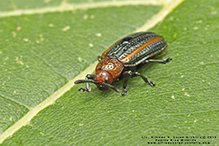 |
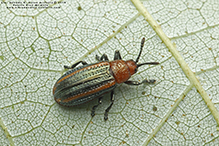 |
|
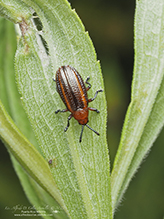 |
||
MinnesotaSeasons.com Photos |
||
|
||
|
||

Slideshows |
|

Visitor Videos |
||
Share your video of this insect. |
||
This button not working for you? |
||
|
Other Videos |
||
Goldenrod Leaf Miner pupa |
About
Feb 23, 2014 rearing Goldenrod Leaf Miner (Microrhopala vittata) larvae from Cup Plant (Silphium perfoliatum) |

Visitor Sightings |
||
Report a sighting of this insect. |
||
This button not working for you? |
||
| Alfredo Colon 8/4/2022 |
Location: Albany, NY |
 |
| Alfredo Colon 8/4/2019 |
Location: Woodbury, MN |
 |
MinnesotaSeasons.com Sightings |
||
|

Created: 11/10/2020 Last Updated: © MinnesotaSeasons.com. All rights reserved. |
